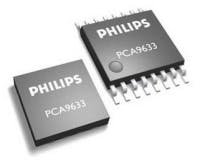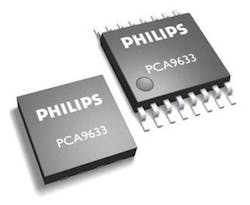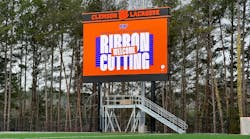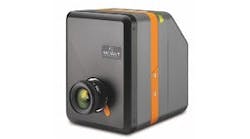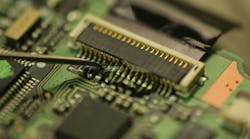Date Announced: 11 May 2006 Royal Philips Electronics has announced the industry’s first I2C Logic devices based on the Fast-mode Plus (Fm+) specification. Initial devices that support Fm+ include 4-bit I2C LED controllers optimized for RGBA color mixing.Steve Blozis, international product marketing manager with Philips Semiconductors, told LEDs Magazine that I2C is already used to drive LEDs, with limited functionality, these are the first products to specifically address the needs of the LED market. "We have devices designed into gaming machines for the lights on the front panel," said Blozis. "We are also having the [new] 9633 designed into lighting fixtures for wall-washing applications."The I2C devices can replace existing, more expensive microcontrollers which require additional components and software. Blozis says that the end user can't alter the I2C device, but if its functionality meets the needs of the end user then the system as a whole will be less complex and easier to implement.Fast-mode PlusThe new I2C Fast-mode Plus specification goes up to a frequency of 1 MHz (1 MB/s) – more than twice the frequency of previous I2C-bus speed specifications – and is backward compatible with existing Fast-mode and Standard-mode devices. In addition, Fm+ increases the total possible capacitance by a factor of 10, enabling longer distance transmission at slower bus speeds without requiring buffers. This allows engineers to create more flexible system designs at higher speeds when more bandwidth is needed, or use larger buses for emerging applications in LED and architectural lighting and gaming, which require a larger number of components on a single bus. “Philips Fast-mode Plus devices allow for more devices on the same bus, faster communication speeds, and longer transmission distances, taking advantage of the advanced features of the new I2C specification,” said Dhwani Vyas, general manager, interface product line, Philips Semiconductors. “Fast-mode Plus will help customers improve performance across a wide range of applications, as the I2C bus is used increasingly for maintenance and control of intelligent devices.” The initial wave of Philips products that will support the 1-MHz Fm+ interface include: PCA9633: 4-bit I2C LED controllers optimized for RGBA color mixingThe Philips PCA9633 is an industry-leading LED driver equipped with four individual pulse-width modulation (PWM) controllers – one for each LED output – and a fifth group PWM that can dim or blink all LEDs with the same value. A new feature in the Fast-mode Plus LED controllers allows software programming of four different addresses that each device will respond to, allowing group and sub-group calls when dimming or blinking groups of LEDs, which will greatly simplify programming. This enables finer-grained control over LED animation and dimming in mobile, entertainment and lighting applications. The higher SDA drive of the Fast-mode Plus LED controllers allows up to 126 devices to operate on the same bus without requiring an extra bus extender on every node. PCA9698: Advanced 40-bit I2C I/O expanderThe Philips PCA9698, a new advanced 40-bit GPIO (general purpose input-output), offers higher bit widths and makes it easier to control and monitor complex systems. Supporting up to 64 devices on the same bus, the PCA9698 offers several advanced features, including 40 I/O pins configurable to totem pole or open drain; output logic states that can change at the Acknowledge or Stop command; maskable inputs that don’t generate interrupts; an Output Enable hardware pin; the GPIO All Call address; and the SMBus Alert function. The Fast-mode Plus I/O expanders can be used across a wide range of applications, such as servers, mobile phones, gaming systems, industrial control, medical equipment and instrumentation. PCA9665: Fast-mode Plus parallel bus to I2C-bus controllersThe Philips PCA9665 bus controller is the first master device capable of communicating at I2C-bus speeds up to 1 MHz or on longer buses up to 4,000 pF. It allows standard parallel-bus microcontrollers and microprocessors to function as Fast-mode Plus capable masters and includes a 68-byte buffer to increase the processor’s productivity. About I2CPhilips invented the I2C bus in the early 1980s and continues to drive innovation in I2C technology. The I2C bus – now the de facto standard for system control – is an elegant two-wire serial bus with a software-defined protocol that provides the communications link between integrated circuits in a system. With I2C, designers can easily and reliably add devices and functions to an existing bus, saving space and lowering overall costs. The new Fast-mode Plus specification, scheduled to be released at the end of Q2 2006, takes I2C to the next level and will mark the first major update to the specification since January 2000. Fm+ goes up to a frequency of 1MHz, versus 400 kHz with Fast-mode, simply by tightening the tolerances and bus timing requirements. Pricing and availabilityThe Philips PCA9633 and PCA9698 are available now, and samples of the PCA9665 are available today. Additional I2C products featuring Fast-mode Plus will be sampling in late Q2 2006.
Contact
Philips I2C Logic devices
Web Site:http://www.philips.com/I2C
